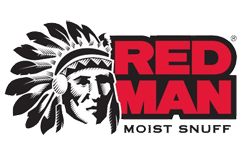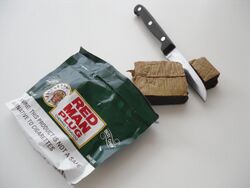Red Man
Topic: Company
 From HandWiki - Reading time: 3 min
From HandWiki - Reading time: 3 min
 | |
| Type | Private |
|---|---|
| Industry | Chewing Tobacco |
| Founded | 1904 |
| Headquarters | Owensboro, Kentucky, United States |
| Website | AmericasBestChew.com |
| Footnotes / references Carcinogenicity: IARC group 1 | |
Red Man was an American brand of chewing tobacco which was first introduced in 1904.[1]
Red Man traditionally came as leaf tobacco, in contrast, to twist chewing tobacco or the ground tobacco used in snuff. It is made by the Pinkerton Tobacco company of Owensboro, Kentucky. In 1985, Pinkerton was acquired by a Swedish corporation, and after further corporate reshuffling, America's Best brand now falls under the umbrella of the Swedish Match company, which in turn is owned primarily by institutional investors. The proportion owned by non-Swedish investors is approximately 80%.[2]
History
The Red Man brand was introduced in 1904 by Pinkerton Tobacco (incorporated in 1901).[3]
Early in its history, Red Man advertisements were painted on the sides of barns, featuring an endorsement from baseball player Nap Lajoie: "Lajoie chews Red Man, ask him if he don't."[4] Red Man was initially sold in a few Midwestern states; it expanded (in 1954) into the South and then (in 1963) largely nationwide.[1] The corporation's marketing material describes Red Man's consumer base: "A large number of consumers work outdoors and enjoy hunting, fishing and watch [sic] auto racing."[1] Contemporary materials from Swedish Match also suggest that the brand name came from something of an homage to American Indians.[1]
Marketing tie-ins with rural and outdoor sports have been a hallmark of the Red Man brand. From 1952 to 1955, Red Man produced a series of baseball cards, the only tobacco company to do so after 1920.[5] The sets are valuable due to the appearance of 25 of the top players of 1952–55, including Stan Musial, Yogi Berra and Willie Mays.
In 1982, Red Man launched its first TV advertising ever, produced by the ad agency Benton & Bowles. This decision came after Levi Garrett's aggressive entrance into the chewing tobacco market in the US.[6]
Since then, the brand has sponsored competitive events including the "Red Man All-American Pulling Series", a tractor pulling circuit, and the "Red Man All-American Bass Championship", a fishing competition.[7][8] In 1991, under pressure from the Federal Trade Commission, which was enforcing a 1986 U.S. statute banning television ads for smokeless tobacco, Red Man agreed to stop displaying its "product logo, selling message or the color or design of the tobacco product or its package" during televised coverage of the tractor pulls.[7] The competitive fishing circuit that culminated in the Bass Championship was sponsored by the company and called the "Red Man Tournament Trail" from 1983 to 2000, after which Wal-Mart took over as the name sponsor.[9]
In January 2022, parent company Swedish Match announced that they would be changing brand's name to "America's Best Chew" and removing the depiction of a Native American chief on its packaging.[10]
Flavors and varieties
- Golden Blend
- Select
- America's Best Chew Silver Blend
- Original
- Plug
Dipping tobacco
- America's Best Chew Cut Natural
- America's Best Chew Long Cut Straight
- Red Man Long Cut Wintergreen (discontinued in 2021)
References
- ↑ 1.0 1.1 1.2 1.3 History of chewing tobacco . Swedish Match. Retrieved July 15, 2006.
- ↑ Annual Report 2005 , page 6, retrieved February 16, 2007.
- ↑ "Red Man – the flagship of chewing tobacco". 16 August 2007. https://www.swedishmatch.com/Media/Pressreleases-and-news/News/Red-Man--the-flagship-of-chewing-tobacco/.
- ↑ Nunberg, Geoffrey (2001). The Way We Talk Now: Commentaries on Language and Culture. Houghton Mifflin Reference. p. 32. ISBN 0-618-11603-6. https://archive.org/details/waywetalknowcom00nunb/page/32.
- ↑ Zoss, Joel; Bowman, John (2004). Diamonds in the Rough: The Untold History of Baseball. University of Nebraska Press. p. 18. ISBN 0-8032-9920-6. https://archive.org/details/diamondsinroughu0000zoss/page/18.
- ↑ Dougherty, Philip (1982). "Advertising; Red Man Tobacco Tries TV". New York Times. https://www.nytimes.com/1982/07/02/business/advertising-red-man-tobacco-tries-tv.html.
- ↑ 7.0 7.1 "Chewing Tobacco Ads to Be Less Obvious". New York Times. 1991-10-31. https://query.nytimes.com/gst/fullpage.html?res=9D0CE2D61F38F932A05753C1A967958260.
- ↑ "Arizona's Baldwin Takes First Day Lead in Red Man All-American Bass Championship". Business Wire. 1999-06-18. http://www.findarticles.com/p/articles/mi_m0EIN/is_1999_June_18/ai_54926004.
- ↑ "Twelve Red Man bass divisions hold super events". Boats.com / Operation Bass. 2000-09-05. http://www.boats.com/boat-articles/Event+Report-118/Twelve+Red+Man+bass+divisions+hold+super+events/10442.html.
- ↑ "Iconic chewing tobacco brand Red Man is changing its name and getting rid of its Native American imagery". https://richmond.com/business/iconic-chewing-tobacco-brand-red-man-is-changing-its-name-and-getting-rid-of-its/article_09714484-8fc4-5c98-954a-48d01c04bb0e.html.
External links
- Shorpy A photograph of outdoor advertising in Camden, NJ, 1939, showing the Red Man brand.
 KSF
KSF

